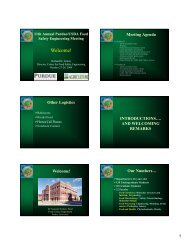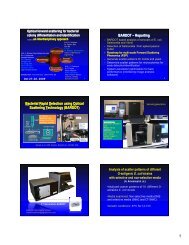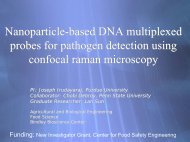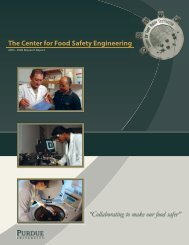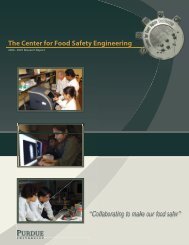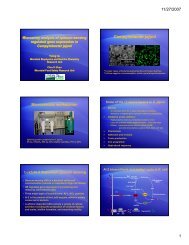Annual Report - Center for Food Safety Engineering - Purdue ...
Annual Report - Center for Food Safety Engineering - Purdue ...
Annual Report - Center for Food Safety Engineering - Purdue ...
You also want an ePaper? Increase the reach of your titles
YUMPU automatically turns print PDFs into web optimized ePapers that Google loves.
Irudayaraj, Mauer, DebRoy and FratamicoDetection of foodborne pathogens via an integratedspectroscopy and biosensor-based approachInvestigators: Joseph Irudayaraj (Department of Agricultural and Biological <strong>Engineering</strong>), Lisa Mauer (Department of <strong>Food</strong>Science), Chitrita DebRoy (The Pennsylvania State University), Pina Fratamico (USDA)Project RationaleZoonotic pathogens such as Salmonella spp., Listeriamonocytogenes, Shiga-toxin producing Escherichia coli(including E. coli O157:H7), and Campylobacter jejuniare recognized as causes of signifi cant and sometimeslethal foodborne illnesses. Identifi cation of these microbialcontaminants is a primary food safety concern in foodproduction, processing, and retail environments. Currentdetection methods <strong>for</strong> E. coli O157:H7 require enrichment <strong>for</strong> 18to 24 hours followed by isolation, prescreening, and confi rmationwith classical biochemical methods or commercially availableassays based on ELISA, antibody precipitation, or PCR. Theseprocedures require up to four days to completely identify E. coliO157:H7. The infective dose <strong>for</strong> Salmonella strains varies withthe server, food, and person. As few as 1 to 10 cells can causeillness, and ranges from 1 to 10 7 CFU/ml of Salmonella strainshave been reported.New technologies <strong>for</strong> detecting foodborne pathogens that arerapid, sensitive, and portable with a potential <strong>for</strong> on-site detectionare needed to help ensure a safe food supply <strong>for</strong> consumers.The ultimate goal of this research was to develop a portableminiaturized infrared sensor <strong>for</strong> specifi c and sensitive detectionof foodborne pathogens. We proposed to integrate samplingand biosensor modules with Fourier trans<strong>for</strong>m infrared/Ramanspectroscopy (FTIR/raman) as well as uv-Visible near infraredspectroscopy to improve detection sensitivity and specifi city.The fi rst steps were to constitute the standardization of FTIRand raman methodologies with the most appropriate samplingsteps <strong>for</strong> sensitivity enhancement and biofunctionalizationsteps <strong>for</strong> specifi city improvement. The second phase focusedon extensive validation using food, as well as mock industrysamples, and translating the benchtop methodologies to aportable mid-infrared device.Project Objectives• Develop and standardize FTIR and raman spectroscopybasedmolecular fi ngerprints (spectra) of foodborneoutbreak strains in conjunction with samplingand regulatory validation in food matrices.• Advance infrared equipment, sampling,testing, and validation capabilities <strong>for</strong> rapididentifi cation of foodborne pathogens.Project HighlightsWe developed a FTIR and raman library of spectroscopicfi ngerprints <strong>for</strong> a total of 28 foodborne pathogenic strains.Of these, 14 were E. coli O157:H7, and two were outbreakstrains. We developed a biosensor protocol using goldnanorods to detect < 10 CFU/ml using a simple ultraviolet-visiblespectrometer. We fi nalized a procedure to per<strong>for</strong>m componentanalysis to understand further the basis and the origin of theFTIR signatures. We constructed and tested the PathoIR chipin the benchtop FTIR. The presence of three signature peaks inthe 850cm -1 to 1100 cm -1 region confi rmed binding of the targetbacteria to the chip surface. We identifi ed a portable systemwhich is twice as sensitive as the current system. This system isalready remarkably promising. However, we believe that this canbe further improved.In summary, our key accomplishment this year was thedevelopment of sensitive nanobiosensors that can providea detection limit of ~10 CFU/ml using a simple visible–nearinfraredspectrometer. The potential exists to further refi nethis technology by integrating a pathogen separation element.Hence, detection in complex mixtures could be per<strong>for</strong>medin one step. This would also facilitate the detection of multiplepathogens at a very high sensitivity level using a simplespectrometer that is af<strong>for</strong>dable and portable.“We developed a FTIR and raman library of spectroscopicfi ngerprints <strong>for</strong> a total of 28 foodborne pathogenic strains.”7<strong>Center</strong> <strong>for</strong> <strong>Food</strong> <strong>Safety</strong> <strong>Engineering</strong>



